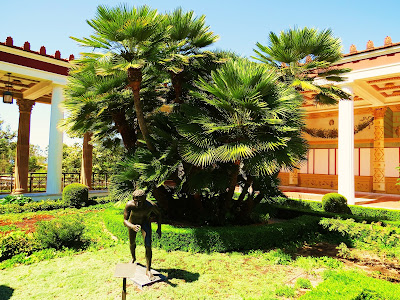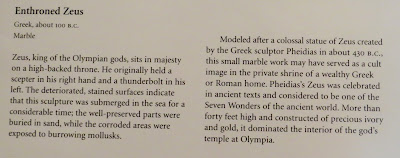This is my electronic photo album on the fabulous Getty Viila, located in Pacific Palisades, California.
The Getty Villa is an educational center and museum dedicated to the study of the arts and cultures of Ancient Greece, Rome and Etruria. The Getty Villa is one of two locations of the J. Paul Getty Museum. The collection has 44,000 Greek, Roman, and Etruscan antiquities dating from 6,500 BC to 400 AD.
The Getty Villa was commissioned by the oil magnate, J. Paul Getty. It is modeled after a first-century Roman country house, the Villa dei Papiri in Herculaneum, Italy. The Villa dei Pariri was buried by the eruption of Mt. Vesevius in AD 79 and much of it remains unexcavated. Therefore, many of the Museum's architectural and landscaping details were designed on elements from other ancient Roman houses in the towns of Pompeii, Herculaneum and Stabiae -- from bronze lanterns like those carried along the streets of Pompeii to herbs and shrubs grown by the Romans for food and ceremony.
The Getty Villa is an educational center and museum dedicated to the study of the arts and cultures of Ancient Greece, Rome and Etruria. The Getty Villa is one of two locations of the J. Paul Getty Museum. The collection has 44,000 Greek, Roman, and Etruscan antiquities dating from 6,500 BC to 400 AD.
The Getty Villa was commissioned by the oil magnate, J. Paul Getty. It is modeled after a first-century Roman country house, the Villa dei Papiri in Herculaneum, Italy. The Villa dei Pariri was buried by the eruption of Mt. Vesevius in AD 79 and much of it remains unexcavated. Therefore, many of the Museum's architectural and landscaping details were designed on elements from other ancient Roman houses in the towns of Pompeii, Herculaneum and Stabiae -- from bronze lanterns like those carried along the streets of Pompeii to herbs and shrubs grown by the Romans for food and ceremony.
The Inner Peristyle provides an intimate spot at the center of the J. Paul Getty Museum. Around a narrow reflecting pool sit replicas of finds from the Villa dei Papiri in Herculaneum, including square marble basins and bronze statues depicting women who have come to draw water from a stream.
The Museum's south doors open onto the Outer Peristyle, the largest garden at the Getty Villa. It is adorned with hedge-lined pathways and circular stone benches. Plants favored by the ancient Romans, such as bay laurel, boxwood, myrtle, ivy, and oleander, are planted around a spectacular 220-foot long reflecting pool. Bronze sculptures, replicas of statues found at the Villa Papiri, are placed in their ancient findspots. A peristyle, or covered walkway, surrounds the formal garden and leads visitors past illusionistic wall paintings to spectacular views of the Pacific Ocean.

















































































